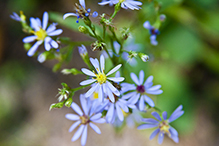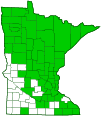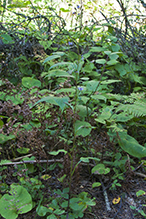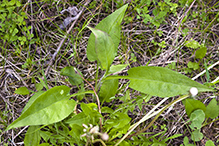Lindley’s aster
(Symphyotrichum ciliolatum)
Conservation • Description • Habitat • Ecology • Use • Distribution • Taxonomy
Conservation Status |
|
|||||||
| IUCN Red List | not listed |
|||||||
| NatureServe | NNR - Unranked SNR - Unranked |
|||||||
| Minnesota | not listed |
|||||||
Description |
||
Lindley’s aster is 8″ to 48″ tall, erect, perennial forb that rises on 1 to 3 or more clustered stems from a long rhizome and sometimes also a branched caudex. It often forms colonies or dense tufts. The stems are erect and straight or somewhat zigzagged. They are almost hairless or sparsely hairy below the inflorescence, sparsely hairy in the inflorescence. Basal leaves are on long, slightly winged leaf stalks. The blades are thin, egg-shaped, usually 1½″ to 4¾″ long, sometimes longer, and ⅝″ to 2¾″ wide. They are usually shallowly heart-shaped, sometimes rounded, at the base, and taper to a point at the tip with straight on concave sides along the tip. The upper surface is hairless or rough to the touch due to the presence of short, stiff hairs. The lower surface is usually densely hairy along the midvein, otherwise sparsely hairy to almost hairless. The margins are coarsely toothed with sharp, forward-pointing teeth. Basal leaves are usually withered at flowering time. Stem leaves are alternate. Lower stem leaves are on long, winged leaf stalks. The blades are thin, egg-shaped, lance-shaped, or inversely lance-shaped, 2⅜″ to 6″ long, and ¾″ to 2⅜″ wide. They are usually shallowly heart-shaped, sometimes wedge-shaped, at the base, and otherwise similar to basal leaves. Lower stem leaves are often withered at flowering time. Stem leaves become gradually smaller, less toothed, and shorter-stalked as they ascend the stem. Upper stem leaves are on short, widely winged, leaf stalks. The blades may be egg lance-shaped, narrowly lance-shaped, or linear, ¾″ to 3″ long, and 3 ⁄16″ to 1″ wide. They are wedge-shaped at the base and sometimes somewhat clasp the stem. The margins are minutely toothed. They are otherwise similar to lower stem leaves. The uppermost leaves are stalkless and untoothed. The inflorescence is an open, branched cluster (panicle) at the end of the stem. The branches of the panicle are ascending. There are usually 13 to 50 flower heads, rarely more than 100. The flower heads are on 1 ⁄16″ to ⅝″ long stalks. Each flower head is 1″ to 1½″ in diameter. The whorl of bracts at the base of the flower head are arranged in 4 or 5 overlapping series and form a bell-shaped, 3 ⁄16″ to ¼″ long cup (involucre). The involucral bracts are usually hairless but sometimes have a fringe of hairs on the margin. There are 14 to 20 pale to deep blue or bluish purple ray florets and 14 to 25 disk florets. The disk florets are yellow at first, eventually becoming reddish-purple. The fruit is a dry achene (cypsela) with white to pinkish bristles attached. |
||
Height |
||
8″ to 48″ |
||
Flower Color |
||
Pale to deep blue or bluish purple |
||
Similar Species |
||
|
||
Habitat |
||
Edges and openings of woods and forests, thickets, streambanks, trails, roadsides. |
||
Ecology |
||
Flowering |
||
Late July to October |
||
Pests and Diseases |
||
|
||
Use |
||
|
||
Distribution |
||||
|
Sources |
|||
| 5/6/2023 | ||||
Nativity |
||||
Native |
||||
Occurrence |
||||
|
||||
Taxonomy |
|||
| Kingdom | Plantae (Plants) | ||
| Division | Tracheophyta (Vascular Plants) | ||
| Subdivision | Spermatophytina (Seed Plants) | ||
| Class | Magnoliopsida (Dicots) | ||
Order |
Asterales (Sunflowers, Bellflowers, Fanflowers, and Allies) | ||
Family |
Asteraceae (Sunflowers, Daisies, Asters, and Allies) | ||
| Subfamily | Asteroideae | ||
| Supertribe | Asterodae | ||
| Tribe | Astereae (asters and allies) | ||
| Subtribe | Symphyotrichinae | ||
| Genus | Symphyotrichum (American asters) | ||
| Subgenus | Symphyotrichum (common American asters) | ||
| Section | Symphyotrichum (bushy, eastern, heart-leaved, and old field asters) | ||
| Subsection | Heterophylli (heart-leaved panicled asters) | ||
This and other asters were formerly place in the genus Aster. That genus was problematic, in that it did not include just one common ancestor with all of its lineal descendants and no others – it was not monophyletic. In 1994, the genus Symphyotrichum was resurrected to include most North American asters formerly in the genus Aster. |
|||
Subordinate Taxa |
|||
|
|||
Synonyms |
|||
Aster ciliolatus Aster ciliolatus var. ciliolatus Aster ciliolatus var. comatus Aster ciliolatus var. wilsonii Aster foliaceus var. subgeminatus Aster lindleyanus Aster saundersii Aster wilsonii Symphyotrichum ciliolatum var. comatum Symphyotrichum ciliolatum var. wilsonii |
|||
Common Names |
|||
ciliated aster fringed blue aster Lindley’s aster northern heart-leaf aster northern heart-leaved aster |
|||
Glossary
Caudex
A short, thickened, woody, persistent enlargement of the stem, at or below ground level, used for water storage.
Clasping
Describing a leaf that wholly or partly surrounds the stem but does not fuse at the base.
Cypsela
A dry, one-chambered, single-seeded fruit, formed from a single carpel, with the seed attached to the membranous outer layer (wall) only by the seed stalk; the wall, formed from the wall of the inferior ovary and also from other tissues derived from the receptacle or hypanthium, does not split open at maturity, but relies on decay or predation to release the contents.
Involucre
A whorl of bracts beneath or surrounding a flower, flower head, or flower cluster.
Linear
Long, straight, and narrow, with more or less parallel sides, like a blade of grass.
Panicle
A pyramidal inflorescence with a main stem and branches. Flowers on the lower, longer branches mature earlier than those on the shorter, upper ones.
Rhizome
A horizontal, usually underground stem. It serves as a reproductive structure, producing roots below and shoots above at the nodes.

Slideshows |
||

Visitor Videos |
|||
Share your video of this plant. |
|||
| This button not working for you? Simply email us at info@MinnesotaSeasons.com. Attach a video, a YouTube link, or a cloud storage link. |
|||
Other Videos |
|||

Visitor Sightings |
|||||
Report a sighting of this plant. |
|||||
| This button not working for you? Simply email us at info@MinnesotaSeasons.com. Be sure to include a location. |
|||||
|
|||||
MinnesotaSeasons.com Sightings |
|||||

|
Created: Last Updated: © MinnesotaSeasons.com. All rights reserved. |



